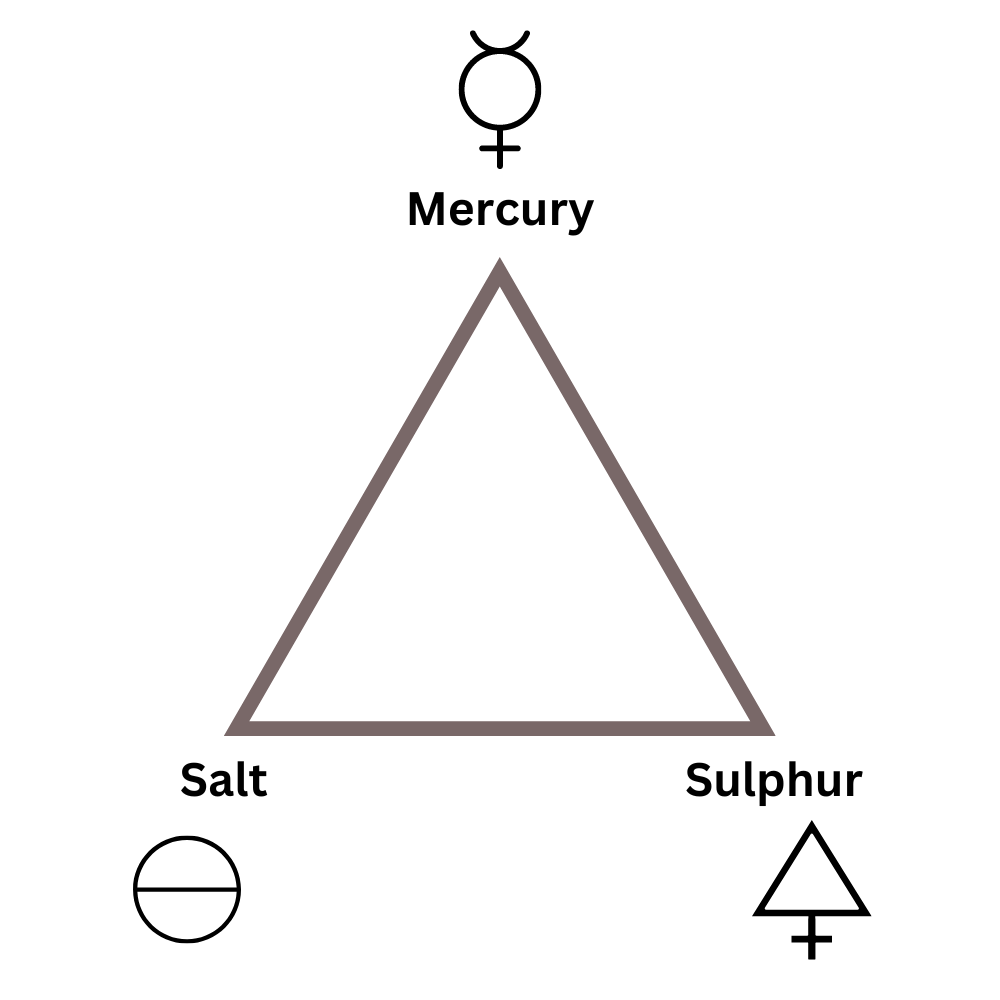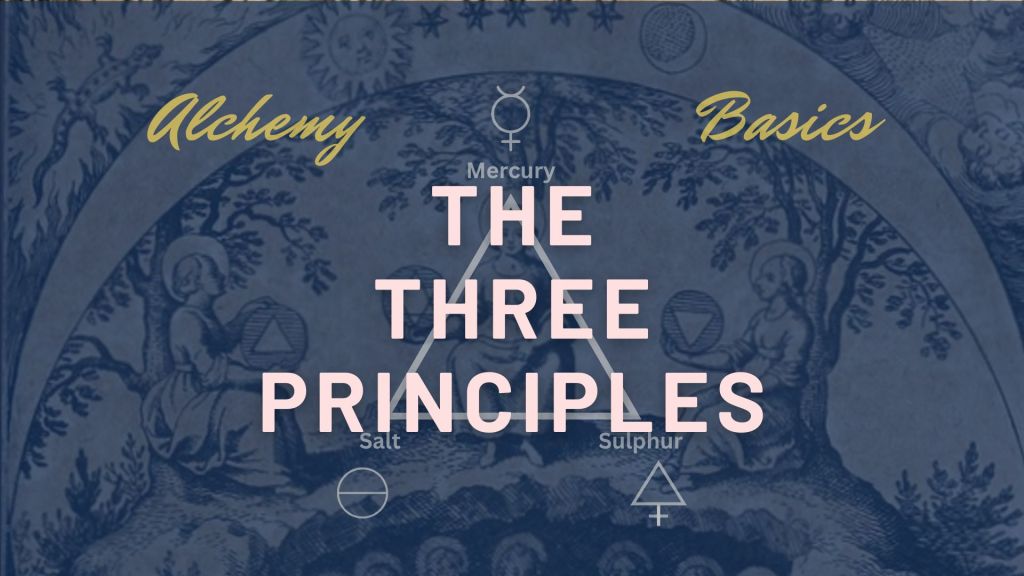It’s time for a little Alchemy today. This is a topic that I plan to return to several times in the future, so let’s just consider this to be the first of many short installments. They’re going to be short because… well, writing about Alchemy is really hard, man. It’s by far one of the most time-consuming concepts I’ve ever put words to.
So what better way to officially begin than to talk about The Three Principles, also known as the tria prima? These are Salt, Sulphur, and Mercury.
But they didn’t start out as three. They actually started out as just two principles. And before that, it was a little more ambiguous. You know what? It’s just easier if we go back about 2500 years.
Aristotle and Meteorologica
Aristotle probably wrote Meteorologica sometime around 340 BCE. It’s composed of four books and deals with the topics of meteorology and chemistry — in fact, it’s the world’s oldest comprehensive work on these subjects. If you’d like to read it, you can. Go ahead, it’s fun. In fact, always read ancient sources before you accept someone’s interpretation of them.
Among other things, Meteorologica discusses the Four Elements (Earth, Water, Air, and Fire). Aristotle didn’t come up with these ideas, but he does make great headway in theorizing how they interact. If you’re familiar with “classical” elemental theory, each element has two of the following qualities: hot, cold, wet, or dry. In a sense, there’s a spectrum of “hot to cold” (active) relationships and “wet to dry” (passive) relationships, the various interplays of which gives us four distinct energy types.
- Earth is cold and dry
- Water is cold and wet
- Air is hot and wet
- Fire is hot and dry

Bust of Aristotle. Public Domain. Courtesy of Wikimedia.
Aristotle also surmised that the Elements could transition from one to another by rotating these qualities. Earth to Water, Water to Air, Air to Fire, Fire to Earth, and round and round we go.
This is all important because he focused on two transition types, or what he called “exhalations.” There are particles of Earth transitioning to Fire, or “earthy smoke,” and particles of Water transitioning to Air, or “watery vapor.”
These two exhalations basically swirl around with each other to create things on earth (the planet, not the element). When there’s more earthy smoke in the mix, it forms minerals and stones. When there’s more watery vapor, it forms metals. Am I simplifying things? Yes, of course I am… because the title of this article wasn’t “Aristotle and the Formation of Metals, Minerals, and Stones Within the Earth,” although I’m sure that would also make for an interesting read.
The Two Principles
Flash forward almost a thousand years to the work of Jabir ibn Hayyan, an 8th-century alchemist who is sometimes hailed as the father of Arabic chemistry.

A 15th century portrait of Jabir. Public Domain. Courtesy of Wikimedia.
He stated that the two exhalations did not directly form metals, minerals, or stones. First, they would have to undergo a phase change themselves.
Earthy smoke would become Sulphur. Watery vapor would become Mercury. It was then the interaction of Sulphur and Mercury that, according to their purity and proportion, formed various metals, minerals, and stones. If everything was pure and perfectly in balance, the result would be every Alchemist’s favorite substance: gold.
Summary: Things mix with other things, which become other things, which, if perfectly balanced, turn into gold. Was that clear enough? This is basically the core of Alchemy, with Sulphur and Mercury being “The Two Principles,” but the ideas aren’t fully formed yet. Luckily, another dude will come forward about 800 years later to give us a third thing, uniting those two other things like a veritable rug that really ties the room together, dude.
The Three Principles
Paracelsus, a 16th-century alchemist and physician, introduced the concept of Salt to Jabir’s Suphur and Mercury.
We now finally have our three principles: Salt, Sulphur, and Mercury, also known as the Tria Prima. These are some of the most foundational concepts to Alchemy as we know it today.
Most of us, however, already have some sort of mental association with these words. In fact, anyone who has taken Chemistry, or maybe even a grade school science class, has heard of them.
First, it’s going to be necessary to break those associations. Salt is not table salt or NaCl or anything else that school ever taught you about the word. Likewise, Sulphur and Mercury are not the elements found on the periodic table.

1538 portrait of Paracelsus by Augustin Hirschvogel. Courtesy of Wikimedia.
We’re dealing with esoteric concepts, similar to how the candle flame is not the element of fire and the ocean is not the element of water. If you want a really good explanation of all of this, you can read The Four Elements of the Wise by Ivo Dominguez Jr. For now, however, let’s just say that Salt, Sulphur, and Mercury can be expressed as combinations of the elements.
You know what would be helpful here? A fancy chart. Don’t worry, I didn’t spend any extra time on making this for you because I already had to make it for a workshop presentation. Reduce, reuse, recycle.

The Three Principles expressed in terms of the Elements
Salt is a combination of Earth and Water and represents the Body. Mercury is a combination of Water and Air and represents the Spirit. Sulphur is a combination of Air and Fire and represents the Soul.
In Paracelsian terms, these three principles show up in their own distinct ways in an Alchemical process. Salt is fixed and is the ash leftover from an experiment. Mercury is a volatile fluid and the spirit or solvent used, typically alcohol. Sulphur is unctuous, fiery, and usually comes across as an oil.
Everything in existence can be broken down into its Salt, Sulphur, and Mercury. This applies to plants, minerals, metals, and even to people. In Alchemy, we separate the three principles, refine them, and put them back together again.
Extrapolations
The Tria Prima has a three-fold nature. Three is a pretty magickal number. If you know me, then you know I just love putting things into triangles. Hang on, I can’t resist doing it at least once within this article.

Sulphur represents the Soul (or consciousness). Salt represents the Body. And Mercury represents the Spirit. Sometimes we say this today as “Mind, Body, Spirit,” which is representative of our existence as humans within these three dimensions. Because Alchemical medicines refine each aspect, they can provide healing on all levels in a way that traditional medicines cannot — but that’s a topic for another day.
What are some other things that have a three-fold nature?
- Three Rays from the Temple of Witchcraft’s Will, Love, and Wisdom
- Three Parts of the Soul
- Three Modalities in Astrology (Cardinal, Fixed, and Mutable)
- Three Pillars on the Qabalistic Tree of Life (Mercy, Severity, and the Middle Pillar)
- Atomic Theory in the sense of Protons, Neutrons, and Electrons
- Sky, Earth, and… that place below the earth
- Sun, Moon, and Stars
- Three Musketeers. Three Wise Man. Three Blind Mice. Three Little Pigs. Alright, enough.
Draw your correspondences however you wish. There’s plenty out there.
Wait, am I forgetting something? I’m pretty sure there’s at least one more. Tree? No. Tri- something. Trin? Trinny? Oh right, the Holy Trinity.
Since Christians love to assimilate things… these three principles are sometimes associated with the Father, Son, and Holy Spirit. In one interpretation, Sulphur is God the Father, Salt is Jesus, and Mercury is the Holy Spirit. Alchemy, which is largely based on Hermetics, can be surprisingly monotheistic at times.
Conclusions
How you choose to use any of this information is completely up to you, but understanding Salt, Sulphur, and Mercury is a critical starting point before delving into the world of Alchemy. It seemed like a good place to start, but I’m sure we’ll come back to this topic another day.
If you’ve got any cool stories to share, or any other interesting things that have a three-fold natures, let me know about them in the comments.
Uh, excuse me, if you aren’t too busy with your labratory experiments, please take a moment to read this fine print. There may be an Amazon referral link within this article. If you use that link to make a purchase, Amazon will pay me a very small commission. Now that that’s out of the way, you can go about your business. Thus endeth the fine print.



Leave a comment